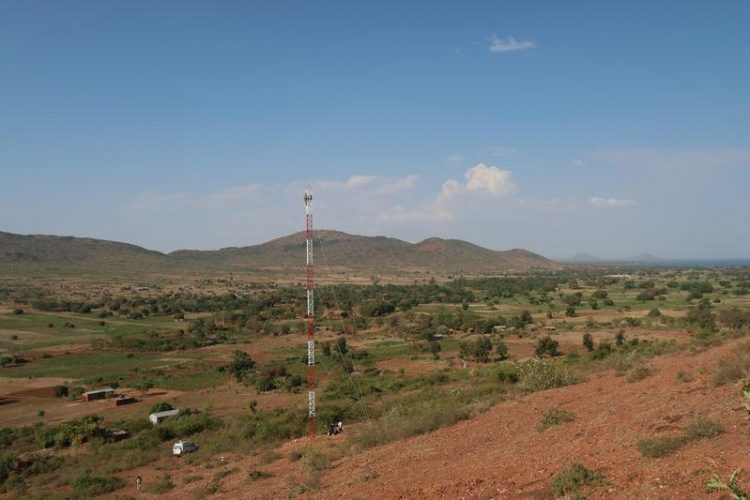Fraunhofer Radio Technology becomes part of the worldwide Telecom Infra Project (TIP)

WiBACK transmitter mast at Bunda, Tansania. With radio masts set up some 10 – 25 km apart, WiBACK can bridge distances of several hundred kilometers. © Fraunhofer FIT
Global Internet penetration has increased significantly in recent decades and finally surpassed the 50% mark of the world's population at the end of 2017. At the same time, however, this means that the other half of the world's population – especially in rural areas – is not yet online.
In rural areas, the high cost of providing connectivity is a major obstacle, as it is offset by an extremely low-income potential for operators. There are many reasons for this, ranging from low population density, infrastructure and skills shortages, insufficiently regulated markets and inflexible business models, to financing problems.
To counter this, the Telecom Infra Project (TIP) was launched in 2016. TIP is an industrial alliance of technology and telecommunications companies, including Deutsche Telekom AG, Intel, Facebook, Telefonica, Vodafone and Nokia Networks. In total, more than 500 member organizations are organized in TIP.
TIP's goal is to provide a global telecommunications network infrastructure that enables global Internet access for all. The focus is on innovative ideas for the implementation of new wireless and fiber-optic technologies and other network components that expand traditional approaches to building and installing network infrastructures.
Fraunhofer FIT was involved in TIP’s OpenCellular since its inception in 2016. WiBACK is a cost-effective solution for bringing broadband Internet to sparsely populated rural areas that are uneconomical for traditional commercial operators. Based on proven protocols in combination with self-organizing processes, WiBACK enables the construction and operation of a fail-safe wireless network without expert knowledge.
WiBACK was developed by Fraunhofer FOKUS and Fraunhofer FIT over more than eight years of research and is already in use in numerous installations in Europe, Africa and South America. WiBACK is a multi-hop point-to-point radio relay solution. With solar-powered transmission towers at intervals of 10-25 kilometers, it can bridge distances of several hundred kilometers.
“We are delighted to become an integral part of the Telecom Infra Project's OpenCellular Project Group. For this purpose, we make parts of our technology available as open-source. WiBACK becomes OC/WiBACK, which will connect the OpenCellular base stations as a backhaul or transport network. In the future, we want to integrate WiBACK technology with OpenCellular Base Stations in a single device in order to bring the Internet to previously untapped regions,” says Dr. Mathias Kretschmer, head of the Network Research department at the Fraunhofer Institute for Applied Information Technology FIT.
The Fraunhofer FIT contributions to TIP and OpenCellular includes:
– Open-source WiBACK Node software
– Field trials and expertise shared with OC and TIP community
– Integration and development efforts to integrate both access and backhaul into a single unit
– Backhauling-related aspects towards an overall OC whitepaper on TV White Spaces
“We are happy to see FIT with its expertise in rural connectivity playing an active role in our OC community. With OC/WiBACK integration, we believe, one can provide sustainable solutions for (deep) rural communities. This work will help us fulfil OpenCelluar’s mission of enabling better rural connectivity, which has the potential to dramatically improve the lives and economic opportunities people living in rural regions.”, says Dr. Kashif Ali, Chair of TIP's OpenCellular Project Group
The OC/WiBACK software will be available as open-source via the OpenCellular github, by end of this year. It allows everyone to develop their own OC/WiBACK-compatible outdoor nodes.
Further information on the WiBACK technology can be found at http://www.wiback.org/en/wiback-technology.html.
Media Contact
More Information:
http://www.fit.fraunhofer.deAll latest news from the category: Information Technology
Here you can find a summary of innovations in the fields of information and data processing and up-to-date developments on IT equipment and hardware.
This area covers topics such as IT services, IT architectures, IT management and telecommunications.
Newest articles

NASA: Mystery of life’s handedness deepens
The mystery of why life uses molecules with specific orientations has deepened with a NASA-funded discovery that RNA — a key molecule thought to have potentially held the instructions for…

What are the effects of historic lithium mining on water quality?
Study reveals low levels of common contaminants but high levels of other elements in waters associated with an abandoned lithium mine. Lithium ore and mining waste from a historic lithium…

Quantum-inspired design boosts efficiency of heat-to-electricity conversion
Rice engineers take unconventional route to improving thermophotovoltaic systems. Researchers at Rice University have found a new way to improve a key element of thermophotovoltaic (TPV) systems, which convert heat…



